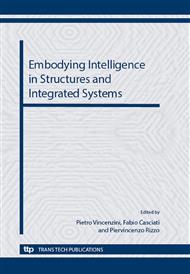[1]
H. Sohn. Effects of environmental and operational variability on structural health monitoring. Philosophical Transactions of the Royal Society, 365:539--560, 2007.
DOI: 10.1098/rsta.2006.1935
Google Scholar
[2]
P. Kraemer. Damage diagnosis approaches for structural health and condition monitoring of offshore wind energy plants. PhD thesis (in German), University of Siegen, 2011.
Google Scholar
[3]
H. Sohn, K. Worden, and C. R. Farrar. Statistical damage classification under changing environmental and operational conditions. Journal of Intelligent Material Systems and Structures, 13:561--574, 2002.
DOI: 10.1106/104538902030904
Google Scholar
[4]
B. Peeters, J. Maeck, and G. De Roeck. Vibration-based damage detection in civil engineering: excitation sources and temperature effects. Smart Materials and Structures, 10:518--527, 2001.
DOI: 10.1088/0964-1726/10/3/314
Google Scholar
[5]
J. Kullaa. Damage detection under a varying environment using the missing data concept. Proc. 5th Int. Workshop on SHM, Stanford, CA, pages 565--573, 2005.
Google Scholar
[6]
J. Kullaa. Elimination of environmental influences from damage-sensitive features in a structural health monitoring system. Proc. 1st Europ. Workshop on SHM, Paris, pages 742--749, 2002.
Google Scholar
[7]
A. Deramaeker, E. Reynders, G. De Roeck, and J. Kullaa. Vibration-based structural health monitoring using output-only measurements under changing environment. Mechanical Systems and Signal Processing, 22:34--56, 2008.
DOI: 10.1016/j.ymssp.2007.07.004
Google Scholar
[8]
A.-M. Yan, G. Kerschen, P. de Boe, and J.-C. Golinval. Structural damage diagnosis under varying environmental conditions - part 2: local pca for non-linear cases. Mechanical Systems and Processing, 19:865--880, 2005.
DOI: 10.1016/j.ymssp.2004.12.003
Google Scholar
[9]
J. Moll, P. Kraemer, and C.-P. Fritzen. Compensation of environmental influences for damage detection using classification techniques. Proc. 4th Europ. Workshop on SHM, pages 1080--1087, 2008.
Google Scholar
[10]
L. E. Mujica, J. Vehi, and J. Rodellar. Non destructive testing for assessing structures by softcomputing. Lecture Notes in Computer Science: Artificial Neural Networks, LNCS 4131:982-- 991, 2006.[11] P. Kraemer, I. Buethe, and C.-P. Fritzen. Damage detection under changing operational and environmental conditions using self organizing maps. Proc. SMART 2011, Smart Structures and Materials, Saarbrcken, Ger., 2011.
DOI: 10.1007/11840930_102
Google Scholar
[12]
P. Kraemer and C.-P. Fritzen. Vibration analysis for structures of offshore wind energy plants. Deutsche Windenergie Konferenz, Bremen, Germany, 2010.
Google Scholar
[13]
G. Bir. Multiblade coordinate transformation and its application to wind turbine analysis. Wind Energy Symposium, Reno, Nevada, 2008.
Google Scholar
[14]
M. Basseville, M. Abdelghani, and A. Benveniste. Subspace-based fault detection algorithms for vibration monitoring. Automatica, 36:101--109, 2000.
DOI: 10.1016/s0005-1098(99)00093-x
Google Scholar
[15]
M. Basseville, F. Bourquin, L. Mevel, and H. Nasserand F. Treyssede. Merging sensor data from multiple temperature scenarios for vibration-based monitoring of civil structures. 3rd European Workshop on Structural Health Monitoring, Madrid, pages 759--766, 2006.
DOI: 10.1177/1475921708089823
Google Scholar
[16]
C.-P. Fritzen, G. Mengelkamp, and A. Guemes. Elimination of temperature effects on damage detection within a smart structure concept. 4th International Workshop on Structural Health Monitoring, Stanford University, USA, pages 1530--1538, 2003.
Google Scholar
[17]
C.-P. Fritzen and P. Kraemer. Vibration based damage detection for structures of offshore wind energy plants. Proc. of 8th International Conference Workshop on SHM, 2:1656--1663, 2011.
Google Scholar
[18]
B. Balasko, J. Abonyi, and B. Feil. Fuzzy clustering and data analysis toolbox. www.fmt.vein.hu/softcomp, 2005.
Google Scholar


